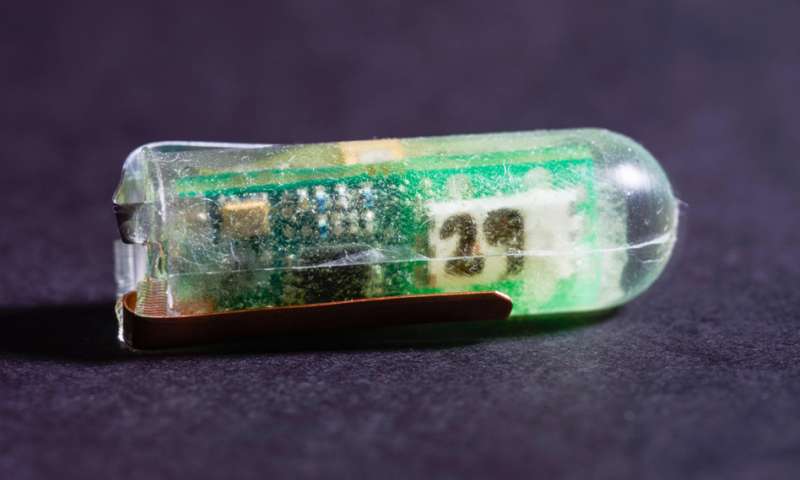A team of researchers at MIT and Brigham and Women’s Hospital designed and demonstrated a small voltaic cell that’s sustained by the acidic fluids in the stomach. Impressively, this system can generate enough power to run small sensors or drug delivery devices that can reside in the gastrointestinal tract for extended periods of time.
According to the researchers, this type of power can offer a safer and lower-cost alternative to the traditional batteries used to power such devices.

New technology could lead to a new generation of electronic ingestible pills that could enable ways of monitoring patient health and treating disease. Image source: phys.org.
“We need to come up with ways to power these ingestible systems for a long time,” said research affiliate at the Koch Institute for Integrative Cancer Research, Giovanni Traverso. “We see the GI tract as providing a really unique opportunity to house new systems for drug delivery and sensing, and fundamental to these systems is how they are powered.”
Traverso and one of the other authors of the study, MIT professor Robert Langer, have previously built and tested many ingestible devices that can be used to sense physiological conditions such as temperature, heart rate, and breathing rate, or to deliver drugs to treat diseases such as malaria.
Langer believes this could lead to a new generation of electronic ingestible pills that could someday enable novel ways of monitoring patient health and treating disease. Currently the devices are powered by small batteries, but conventional batteries self-discharge over time and pose a safety risk. To overcome such disadvantages, Langer and Traverso worked with Anantha Chandrakasan, head of MIT’s Department of Electrical Engineering, and Philip Nadeau, the lead author of the paper. Both researchers specialize in developing low-power electronics.
To begin, the team took inspiration from a simple type of voltaic cell known as a lemon battery, consisting of two electrodes — often a galvanized nail and a copper penny — stuck in a lemon. The lemon’s citric acid carries a small electric current between the two electrodes.
To replicate that strategy, the researchers attached zinc and copper electrodes to the surface of the ingestible sensor. The zinc emitted ions into the acid in the stomach to power the voltaic circuit, generating enough energy to power a commercial temperature sensor and a 900-megahertz transmitter.
Next, the team tested their idea in pigs. It took an average of six days for the device to travel through the digestive tract, and while in the stomach, the voltaic cell produced enough energy to power a temperature sensor and to wirelessly transmit the data to a base station located two meters away, with a signal sent every 12 seconds. Once in the small intestine, the cell generated only about 1/100 of what it produced in the stomach.
The current prototype of the device is a cylinder about 40 millimeters long and 12 millimeters in diameter, but the researchers anticipate that they could make the capsule about one-third its size by building a customized integrated circuit that would carry the energy harvester, transmitter, and a small microprocessor. Once the researchers miniaturize the device, they anticipate adding other types of sensors and developing it for applications such as long-term monitoring of vital signs.
The new device could also be used for drug delivery. In the study, the researchers demonstrated that they could use the power generated by the voltaic cell to release drugs encapsulated by a gold film. This could come in handy for doctors when they need to try out different dosages of drugs, such as a medication for controlling blood pressure.
Source: phys.org
Advertisement
Learn more about Electronic Products Magazine





